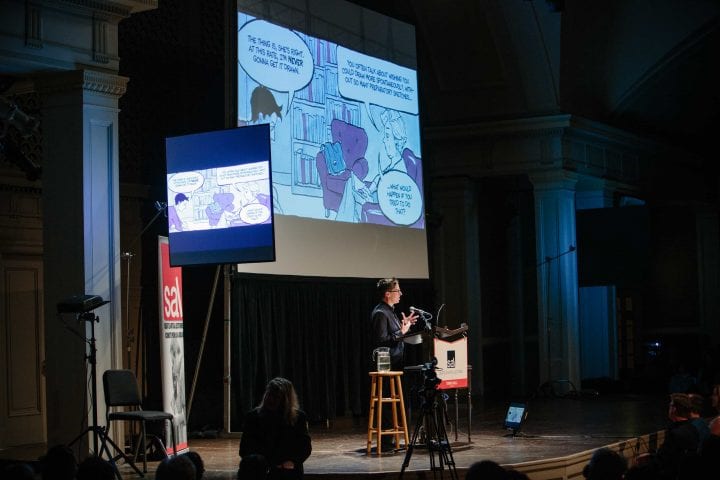
Following In Her Own Footprints: Alison Bechdel’s Circles of Creativity
November 13, 2015
By Amelia Peacock, SAL Community Engagement Coordinator
In one of A. A. Milne’s most iconic stories featuring everyone’s favorite “bear of very little brain,” Pooh and his best friend Piglet spot what they think are Heffalump tracks in the snow on one of their many walks in the woods. They begin tracking this mysterious, elusive creature around and around a nearby tree, marveling at how the footprints in the snow multiply, and growing more and more anxious to discover their prey. Finally the two friends realize they have been chasing their own footprints all along.
In front of a sold out house at Town Hall Seattle, cartoonist Alison Bechdel clicked to this image of Pooh and Piglet examining multiple sets of snowy tracks under black, gnarled branches. She explained to appreciative laughter that this was essentially a picture of her creative process. However, unlike Pooh and Piglet’s fruitless wanderings, Bechdel’s circles have a purpose. She seems to return to the beginning of her creative path each time with renewed vigor and insight. Bechdel went on to highlight several of these creative circles as signposts in her life and work as a child, a young, unknown artist, and a mature overnight sensation.
Bechdel began the nuanced slide show of her life with images of her earliest drawings. The audience watched as her skill morphed from whimsical stick figures to robust characters, from blank backgrounds to painstakingly layered scenes. Bechdel reminisced about the “early, uncomplicated relationship” she had with her art. She thanked her parents for throwing her the “amazing life raft of writing and drawing,” a floating safe haven she much preferred to being on the chaotic boat that was her life at home. Her art allowed her to distance herself from the reality of her situation, documenting it instead of internalizing it.
The innate drive to document her life carried Bechdel into the next circle of her process, her critically acclaimed comic strip Dykes to Watch Out For. The strip became a chronicle of a culture struggling with homosexual hostility. As Bechdel told the audience, “Living openly queer became a job.” However, although the title of the series implies a very specific readership, it appeals to a much wider audience of people who felt otherwise alone in a society that did not accept them for a myriad of reasons including the color of their skin and their sexual orientation.
Hardship struck with the death of Bechdel’s father. The artist turned to a therapist to help puzzle out her complex relationship with her family, unearthing both depression and inspiration. Bechdel characterized her mental state as “a sign post to pay attention to.” Her work had become overworked and she longed to “get back to the energy of childhood, that freely flowing creativity.” She returned to her writing roots, this time chronicling her path with life-size drawings stroked onto long sheets of craft paper. The drawings were meant to be part of an art installation, but Bechdel continued the practice far beyond the gallery opening. In a matter of months her partner moved out, her mother fell ill and her cat died, so she filled the empty space with giant drawings. The only rule Bechdel set was that there could be no premeditation of any kind. Each night she would take out a fresh sheet and simply draw the first thing that came to mind. As the audience saw in her slides, this period often included forlorn figures, dark faces and shadows of cats. However, soon new feline friends entered the picture, Bechdel’s bestseller “Fun Home” became a hit Broadway musical, and Bechdel’s life and work became instantly brighter.
By the end of her presentation, it was clear that Bechdel had yet again come full circle and was ready for the next orbital iteration of her art. Like Pooh and Piglet examining the many tracks in the snow, Bechdel credited her artistic processes of reflection as giving her the most comfort because it was only by stepping back to realize what was happening to her life and art that she felt the most present.